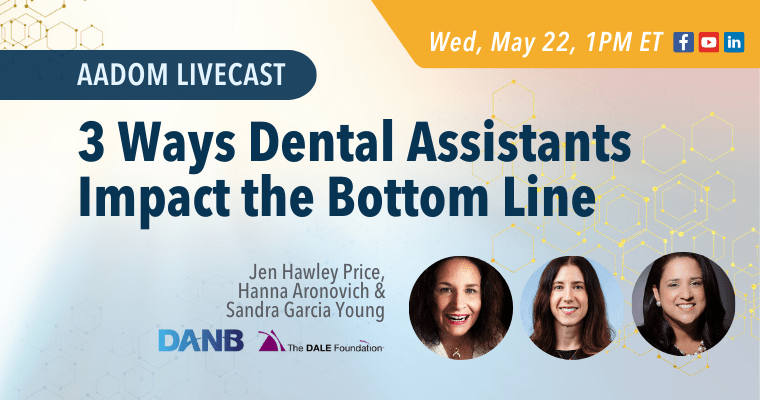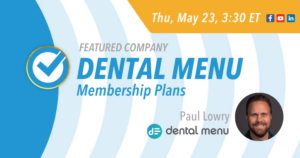Upcoming AADOM LIVEcast – 3 Ways Dental Assistants Impact the Bottom Line

In today’s economic environment, dental practices need to be highly focused and efficient to maintain maximum profitability. Not only do practices need to address rising operating costs, staffing issues remain a top challenge. On average, dental practices look to fill at least one dental assisting position each year, and most report that it is very challenging to do so. But what does this cost your practice exactly?
New research uncovers the specific costs of open dental assisting positions, including the impact on revenue and productivity, and provides guidance on strategies dental leaders can take to reap positive financial returns.
The results of the research reflect responses from dental team leaders responsible for the staffing, scheduling, billing, and overall financial management of dental practices, including dentists, office managers, and practice administrators – including many AADOM members.
Join us for this info-packed session to be among the first to get the results. You’ll learn about the true costs of turnover, including the lost time and revenue associated with hiring and onboarding a new dental assistant. You’ll also learn what you can do to mitigate dental assistant turnover, reduce associated hiring and training costs, maintain productivity levels, and preserve at-risk revenue.
We’ll also share the toolkit we’ve developed to help you make sound recommendations for your dental practice based on your own practice’s financial data. And, we’ll hear from a practice administrator who has helped build a positive work culture at her clinic, which has led to strong employee loyalty and high retention.
This session will be full of data, resources, and real-world advice. Don’t miss out!
Course Learning Objectives:
By the end of this webinar, you’ll be able to:
- Describe the financial impact of dental assistants on the dental practice
- Explain how patient visits are addressed when the dental assistant is out of the office
- Cite the average time for a practice to hire and train a dental assistant
- Calculate turnover costs and at-risk revenue
- Analyze the costs and returns related to dental assistant wages and turnover
Please note, this session is being simulcast on the AADOM Facebook Page, the AADOM LinkedIn Page, and the AADOM YouTube Channel to view on 5/22/24 at 1:00 pm Eastern
Learn about the presenters:
Jen Hawley Price, M.S., MAS, is the Chief Learning and Engagement Officer at the Dental Assisting National Board (DANB) and the DALE Foundation. She oversees DALE Foundation educational products and supports DANB and DALE Foundation strategic initiatives. She earned a Master of Applied Science in Patient Safety and Healthcare Quality from Johns Hopkins University.
 Hanna Aronovich is the Chief Marketing and Strategy Officer at the Dental Assisting National Board (DANB) and the DALE Foundation. She has been with DANB and the DALE Foundation for more than 15 years. Previously, she worked at Edelman on public relations and communications campaigns for numerous healthcare clients. She began her career as a writer and editor for business publications and has a bachelor’s degree from the University of Illinois at Chicago.
Hanna Aronovich is the Chief Marketing and Strategy Officer at the Dental Assisting National Board (DANB) and the DALE Foundation. She has been with DANB and the DALE Foundation for more than 15 years. Previously, she worked at Edelman on public relations and communications campaigns for numerous healthcare clients. She began her career as a writer and editor for business publications and has a bachelor’s degree from the University of Illinois at Chicago.
Sandra Garcia Young, CDA, CDIPC, RDA, FADAA, FAADOM, of San Antonio, Texas, is the Practice Administrator for CentroMed, one of Texas’s largest nonprofit Federally Qualified Health Centers. She has over 20 years of clinical experience and has worked in a variety of specialties. Previously, Sandra was the Dental Assisting Program Director at the Academy of Health Care Professions in San Antonio, Texas, where more than 300 students graduated from the dental assisting program during her tenure.






